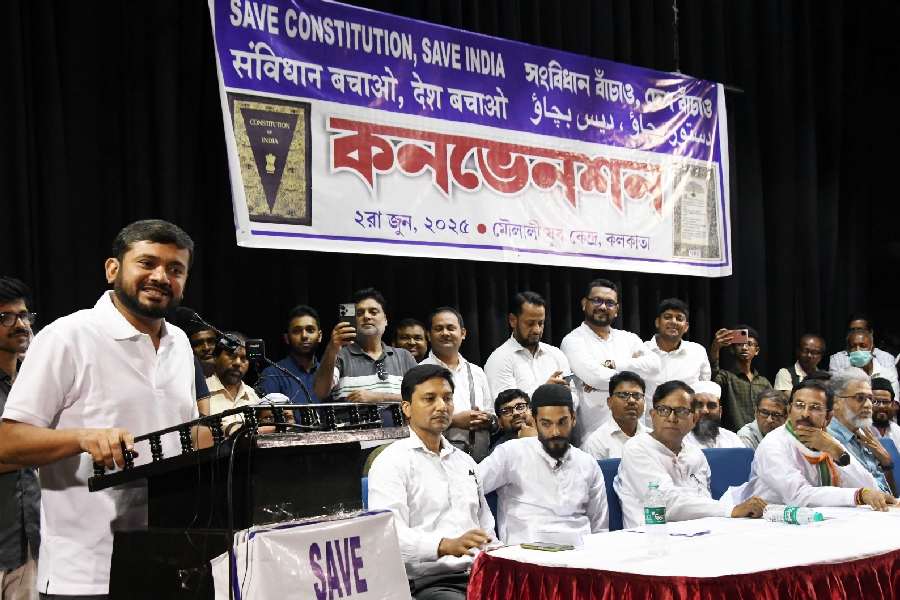

Tinsukia/Itanagar, Aug. 11: Floodwaters submerged more villages and cropland in Arunachal Pradesh today as the major rivers and their tributaries rose, fed by incessant rain.
The Sino-Indian border adjacent to Arunachal's Dibang Valley district remained cut-off for the second consecutive day after the Deopani washed away Siku bridge, the only link connecting Dibang Valley with the rest of India, yesterday.
The bridge, located 3km from Roing town, the headquarters of Lower Dibang Valley district, was the only link to Anini, the headquarters of Dibang Valley district.
"The loss of the bridge over the Deopani and landslides ahead have completely cut off Hunli subdivision of Roing district, its adjacent Debang Valley district and the Sino-Indian border along Debang Valley from the rest of the country, which is a reason to worry," Roing deputy commissioner Deepak Shinde told The Telegraph .
A source said the new bridge being constructed parallel to the old bridge over Deopani will not be ready for at least a year. While people can cross it on foot, though it is risky, movement of vehicles has been cut off completely.
The loss of the Deopani bridge assumes significance given India's stand-off with China over Doklam. The washing away of the bridge has cut off the movement of armed forces to the border from Anini, the last district headquarters before the Sino-Indian border.
A senior army officer, however, told The Telegraph, " Perhaps it has hindered the movement of troops and ammunition to the China border but the army is always prepared for any eventuality and has alternatives. We have enough stock on the other side to counter any situation."
He did not spell out the alternatives.
Shinde said the rise in water levels of the major rivers in eastern Arunachal Pradesh had triggered massive floods in Roing, Namsai and Tezu districts.
As a result, Dambuk subdivision under Roing district, which has more than 10 villages under it, has been completely cut off from both Roing and Pasighat sides, he added. However, barring a major jolt to connectivity, no substantial damages to villages and cropland had been reported from Roing, as it is located on a hilly area, he said.
In neighbouring Namsai, massive soil erosion and loss of private property was reported. The Noa-Dihing and other rivers and their tributaries were flowing close to the danger mark.
Over 200 hectares of cultivated land was submerged. Reports of damages to houses, granaries, cattle sheds was pouring in. Dirak Miri, Lekang Gohaingaon, Rajabeel, Mokrun and Nongtaw Khamti were the villages worst affected.
Namsai deputy commissioner R.K. Sharma said, "Altogether 756 people from 105 families have been severely affected in Lekang circle but no loss of life has been reported. The rivers are also threatening Alubari and Chowkham circle. Relief materials are being provided to the affected people and people living along river banks have been alerted. The actual loss can be assessed only after the water level recedes."
The district administration has directed officials to monitor the flood situation and take precautionary measures to avert any untoward incident. Complete ban on fishing has been imposed.
In East Siang district, flash flood swept through Siluk village in Mebo circle yesterday afternoon, inundating houses and damaging property. However, no casualty was reported.
Pasighat town too is reeling under water. The district authorities have alerted the people about more rainfall.
Incessant rainfall for the past three days has snapped communication on National Highway 415, one of the two roads connecting Itanagar with rest of the country via Assam.
A major portion of the highway, the only link from Banderdewa, the gateway to Arunachal, to the twin capital cities of Naharlagun and Itanagar, was washed away near Karsingsa, 30km from Itanagar, following heavy rain last night and this morning. This has stopped traffic movement on the highway completely.
PWD executive engineer Nani Tath said the road would be restored for light vehicles within a day or two if the weather permits. He said the chief engineer had been informed and it was for the department to decide if it would restore the path by constructing a bridge or by cutting earth.










